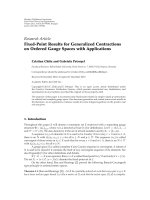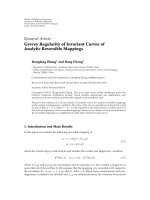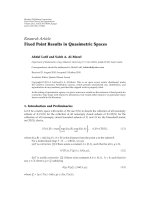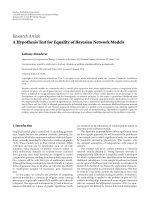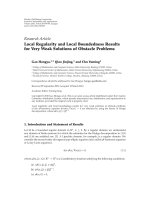Báo cáo hóa học: " Research Article Local Regularity Results for Minima of Anisotropic Functionals and Solutions of Anisotropic Equations" pptx
Bạn đang xem bản rút gọn của tài liệu. Xem và tải ngay bản đầy đủ của tài liệu tại đây (511 KB, 11 trang )
Hindawi Publishing Corporation
Journal of Inequalities and Applications
Volume 2008, Article ID 835736, 11 pages
doi:10.1155/2008/835736
Research Article
Local Regularity Results for Minima of Anisotropic
Functionals and Solutions of Anisotropic Equations
Gao Hongya,
1, 2
Qiao Jinjing,
1
Wang Yong,
3
and Chu Yuming
4
1
College of Mathematics and Computer Science, Hebei University, Baoding 071002, China
2
Study Center of Mathematics of Hebei Province, Shijiazhuang 050016, China
3
Department of Mathematics, Chengde Teachers College for Nationalities, Chengde 067000, China
4
Faculty of Science, Huzhou Teachers College, Huzhou 313000, China
Correspondence should be addressed to Gao Hongya,
Received 13 July 2007; Accepted 21 November 2007
Recommended by Alberto Cabada
This paper gives some local regularity results for minima of anisotropic functionals I u; Ω
Ω
fx,
u, Dudx, u ∈ W
1,q
i
loc
Ω and for solutions of anisotropic equations −divAx, u, Du−
N
i1
∂f/
∂x
i
, u ∈ W
1,q
i
loc
Ω which can be regarded as generalizations of the classical results.
Copyright q 2008 Gao Hongya et al. This is an open access article distributed under the Creative
Commons Attribution License, which p ermits unrestricted use, distribution, and reproduction in
any medium, provided the original work is properly cited.
1. Introduction
Let Ω be an open bounded subset of R
N
, N ≥ 2. Let q
i
> 1, i 1 , ,N.Denote
q max
1≤i≤N
q
i
,p min
1≤i≤N
q
i
, q :
1
q
1
N
N
i1
1
q
i
. 1.1
Throughout this paper, we will make use of the anisotropic Sobolev space
W
1,q
i
loc
Ω
v ∈ L
q
loc
Ω :
∂v
∂x
i
∈ L
q
i
loc
Ω, ∀i 1, ,N
. 1.2
Let x
0
∈ Ω and t>0, we denote by B
t
the ball of radius t centered at x
0
. For functions u and
k>0, let A
k
{x ∈ Ω : |ux| >k}, A
k,t
A
k
∩ B
t
. Moreover, if p>1, then p
is always the real
number p/p − 1,andifs<N, s
∗
is always the real number satisfying 1/s
∗
1/s − 1/N.
This paper mainly considers the functions u minimizing the anisotropic functionals
Iu; Ω
Ω
fx, u, Dudx, u ∈ W
1,q
i
loc
Ω 1.3
2 Journal of Inequalities and Applications
and weak solutions of the anisotropic equations
−divAx, u , Du−
N
i1
∂f
i
∂x
i
,u∈ W
1,q
i
loc
Ω. 1.4
We refer to the classical books by Lady
ˇ
zenskaya and Ural’ceva 1, Morrey 2, Gilbarg and
Trudinger 3, and Giaquinta 4 for some details of isotropic cases.
For isotropic cases, global L
s
-summability was proved in the 1960s by Stampacchia 5
for solutions of linear elliptic equations. This result was extended by Boccardo and Giachetti to
the nonlinear case in 6. For anisotropic cases, Giachetti and Porzio recently proved in 7 the
local L
s
-summability for minima of anisotropic functionals and weak solutions of anisotropic
nonlinear elliptic equations. Precisely, the authors considered the minima of functionals whose
prototype is 1.3, f is a Carath
´
eodory function satisfying the growth conditions
a
N
i1
ξ
i
q
i
≤ fx, s, ξ ≤ b
N
i1
ξ
i
q
i
ϕ
1
x, 1.5
where the function ϕ
1
∈ L
r
loc
Ω with 1 <r<N/q. The authors also considered the local
solutions u ∈ W
1,q
i
loc
Ω of the anisotropic equations 1.4,whereA : Ω × R × R
N
→ R
N
is a
Carath
´
eodory function satisfying the following structural conditions:
Ax, u, ξ·ξ ≥ m
0
N
i1
ξ
i
q
i
,
A
j
x, u, ξ
≤ m
1
hx
N
i1
|ξ
i
|
q
i
1−1/q
j
,j 1, ,N,
1.6
where m
l
,l 0, 1 are positive constants, the function h is in L
1
loc
Ω and the functions f
i
belong,
respectively, to the spaces L
q
i
loc
Ω. Under the above conditions, the authors obtained some
local regularity results.
The aim of the present paper is to prove the local regularity property for minima of the
anisotropic functionals of type 1.3 with the more general growth conditions than 1.5,that
is, we assume the integrand f satisfies the following growth conditions:
N
i1
ξ
i
q
i
− b
u
α
− ϕ
0
x ≤ fx, u, ξ ≤ a
N
i1
ξ
i
q
i
b|u|
α
ϕ
1
x, 1.7
where
ϕ
0
∈ L
r
1
loc
Ω,ϕ
1
∈ L
r
2
loc
Ω,r
1
,r
2
> 1,a≥ 1,b≥ 0,
p ≤ α<p
∗
,q<q
∗
, q<N, 1 < min
r
1
,r
2
<
N
q
.
1.8
We also consider weak solutions of the type 1.4 with more general growth conditions than
1.6, that is, we assume the operator A satisfies the following coercivity and growth condi-
tions:
Ax, u, ξ· ξ ≥ b
0
N
i1
ξ
i
q
i
− b
1
|u|
α
1
− ϕ
2
x, 1.9
Ax, u, ξ
≤ b
2
N
i1
ξ
i
q
i
−1
b
3
|u|
α
2
kx, 1.10
Gao Hongya et al. 3
where b
0
≥ 1, b
i
> 0, i 1, 2, 3, q<q
∗
, q<N, p ≤ α
1
<p
∗
, p − 1 ≤ α
2
≤ Np − 1/N − p,
ϕ
2
∈ L
r
0
loc
Ω with r
0
> 1, k ∈ L
r
N1
loc
Ω, f
i
∈ L
r
i
loc
Ω, i 1, ,N.
Remark 1.1. Notice that we have confined ourselves to the case
q<Nbecause when such
inequality is violated, every function in W
1,q
i
loc
Ω is trivially in L
s
loc
Ω for every fixed s<∞
by 7, Lemma 3.2.
Remark 1.2. Since we have assumed in 1.7, 1.9,and1.10 that the integrand f and the
operator A satisfy some growth conditions depending on u, in the proof of the local regularity
results, w e have to estimate the integral of some power of |u| by means of |Du|.Todothis,we
will make use of the Sobolev inequality that has been used in 8.
2. Preliminary lemmas
In order to prove the local L
s
-integrability of the local unbounded minima of the anisotropic
functionals and weak solutions of anisotropic equations, we need a useful lemma from 7.
Lemma 2.1. Let u ∈ W
1,q
i
loc
Ω, φ
0
∈ L
r
loc
Ω,whereq, q,andr satisfy
1 <r<
N
q
,q<
q
∗
, q<N. 2.1
Assume that the following integral estimates hold:
A
k,τ
N
i1
∂u
∂x
i
q
i
dx ≤ c
0
A
k,t
φ
0
dx t − τ
−γ
A
k,t
N
i1
|u|
q
i
dx
2.2
for every k ∈ N and R
0
≤ τ<t≤ R
1
,wherec
0
is a positive constant that depends only on N, q
i
, r, R
0
,
R
1
and |Ω| and γ is a real positive constant. Then u ∈ L
s
loc
Ω,where
s
q
∗
q
q − q
∗
1 − 1/r
. 2.3
One will also need a lemma from [8].
Lemma 2.2. Let ft be a nonnegative bounded function defined for 0 ≤ T
0
≤ t ≤ T
1
. Suppose that for
T
0
≤ t<s≤ T
1
,
ft ≤ As − t
−γ
B θfs, 2.4
where A, B, γ, θ are nonnegative constants, and θ<1. Then there exists a constant c, depending only
on γ and θ such that for every , R, T
0
≤ <R≤ T
1
, one has
f ≤ c
AR −
−γ
B
. 2.5
4 Journal of Inequalities and Applications
3. Minima of anisotropic functionals
In this section, we prove a local regularity result for minima of anisotropic functionals.
Definition 3.1. By a local minimum of the anisotropic functional I in 1.3, we mean a function
u ∈ W
1,q
i
loc
Ω, such that for every function ψ ∈ W
1,q
i
Ω with supp ψ ⊂⊂ Ω, it holds that
Iu; supp ψ ≤ Iu ψ; supp ψ. 3.1
Theorem 3.2. Assume that the functional I satisfies the conditions 1.7.Ifu is a local minimum of I,
then it belongs to L
s
loc
Ω,where
s
q
∗
q
q − q
∗
1 − 1/ min
r
1
,r
2
. 3.2
Proof. Owing to Lemma 2.1,itissufficient to prove that u satisfies the integral estimates 2.2
with γ q and φ
0
ϕ
0
ϕ
1
.LetB
R
1
⊂⊂ Ω and 0 ≤ R
0
≤ τ<t≤ R
1
be arbitrarily but fixed. It is
no loss of generality to assume that R
1
− R
0
< 1. For k>0, let
A
k
x ∈ Ω : ux >k
,A
−
k
x ∈ Ω : ux < −k
. 3.3
It is obvious that A
k
A
k
∪ A
−
k
.DenoteA
k,t
A
k
∩ B
t
and A
−
k,t
A
−
k
∩ B
t
.Letw maxu − k,0.
Choose ψ −ηw in 3.1,whereη is a cut-off function such that
supp η ⊂ B
t
, 0 ≤ η ≤ 1,η 1inB
τ
, |Dη|≤2t − τ
−1
. 3.4
We obtain from the minimality of u that
B
t
fx, u, Dudx ≤
B
t
fx, u ψ, Du Dψdx
A
k,t
f
x, u − ηw, Du − Dηw
dx
B
t
∩{u≤k}
fx, u, Dudx.
3.5
This implies that
A
k,t
fx, u, Dudx ≤
A
k,t
f
x, u − ηw, Du − Dηw
dx. 3.6
By 1.7,weobtain
A
k,t
N
i1
∂u
∂x
i
q
i
dx
≤ b
A
k,t
u
α
dx
A
k,t
ϕ
0
dx a
A
k,t
N
i1
∂u
∂x
i
−
∂ηw
∂x
i
q
i
dx b
A
k,t
u − ηw
α
dx
A
k,t
ϕ
1
dx.
3.7
Gao Hongya et al. 5
We first estimate the 3rd term on the right-hand side of 3.7. Using the elementary inequality
a b
q
≤ 2
q−1
a
q
b
q
,a,b≥ 0,q≥ 1, 3.8
we obtain
a
A
k,t
N
i1
∂u
∂x
i
−
∂ηw
∂x
i
q
i
dx a
A
k,t
\A
k,τ
N
i1
∂u
∂x
i
−
∂ηw
∂x
i
q
i
dx
≤ 2
q−1
a
A
k,t
\A
k,τ
N
i1
1 − η
q
i
∂u
∂x
i
q
i
∂η
∂x
i
q
i
w
q
i
dx
≤ 2
q−1
a
A
k,t
\A
k,τ
N
i1
∂u
∂x
i
q
i
dx
2
2q−1
a
t − τ
q
i
A
k,t
\A
k,τ
N
i1
w
q
i
dx
≤ 2
q−1
a
A
k,t
\A
k,τ
N
i1
∂u
∂x
i
q
i
dx
2
2q−1
a
t − τ
q
A
k,t
\A
k,τ
N
i1
u
q
i
dx
3.9
since w
q
i
≤ u
q
i
in A
k,t
and t − τ<1. The summation of the 1st and the 4th terms on the right-
hand side of 3.7 can be estimated as
b
A
k,t
u
α
dx b
A
k,t
u − ηw
α
dx ≤ 2b
A
k,t
u
α
dx. 3.10
Substituting 3.9 and 3.10 into 3.7 yields
A
k,t
N
i1
∂u
∂x
i
q
i
dx
≤
A
k,t
ϕ
0
ϕ
1
dx 2b
A
k,t
u
α
dx 2
q−1
a
A
k,t
\A
k,τ
N
i1
∂u
∂x
i
q
i
dx
2
2q−1
a
t − τ
q
A
k,t
\A
k,τ
N
i1
u
q
i
dx.
3.11
We know from 8 that if u ∈ W
1,p
B
t
and | supp u|≤1/2|B
t
|,wethenhavetheSobolev
inequality
B
t
u
p
∗
dx
p/p
∗
≤ c
1
N, p
B
t
|Du|
p
dx. 3.12
Let
u
⎧
⎨
⎩
u, x ∈ A
k,t
,
0,x∈ Ω \ A
k,t
.
3.13
6 Journal of Inequalities and Applications
By assumption, p ≤ α<p
∗
, which implies
A
k,t
u
α
dx
B
t
u
α
dx ≤u
α−p
p
∗
B
t
1−α/p
∗
B
t
u
p
∗
dx
p/p
∗
≤ c
1
u
α−p
p
∗
B
t
1−α/p
∗
B
t
|Du|
p
dx
≤ c
1
u
α−p
p
∗
B
t
1−α/p
∗
max
1, 2
p/2−1
B
t
N
i1
∂u
∂x
i
q
i
dx
c
1
u
α−p
p
∗
B
t
1−α/p
∗
max
1, 2
p/2−1
A
k,t
N
i1
∂u
∂x
i
q
i
dx,
3.14
provided that |supp u|
B
t
|≤1/2|B
t
|. We can choose T so small that for t ≤ T we get
c
1
u
α−p
p
∗
B
t
1−α/p
∗
max
1, 2
p/2−1
≤
1
4b
. 3.15
It is obvious that
k
p
∗
A
k
≤u
p
∗
p
∗
, Ω
, 3.16
and therefore, there exists a constant k
0
, such that for k ≥ k
0
,wehave
A
k
≤
1
2
B
T/2
. 3.17
For such values of k we then have |supp u| < 1/2|B
T/2
| and therefore, if T/2 ≤ t ≤ T,
A
K,t
u
α
dx ≤
1
4b
A
K,t
N
i1
|
∂u
∂x
i
|
q
i
dx. 3.18
Thus, from 3.11 and, we get
A
k,t
N
i1
∂u
∂x
i
q
i
dx
≤ 2
A
k,t
ϕ
0
ϕ
1
dx 2
q
a
A
k,t
\A
k,τ
N
i1
∂u
∂x
i
q
i
dx
2
2q
a
t − τ
q
A
k,t
\A
k,τ
N
i1
u
qi
dx.
3.19
Suppose now T/2 ≤ ≤ τ<t≤ R ≤ T,weget
A
k,
N
i1
∂u
∂x
i
q
i
dx
≤ 2
A
k,R
ϕ
0
ϕ
1
dx 2
q
a
A
k,t
\A
k,
N
i1
∂u
∂x
i
q
i
dx
2
2q
a
t − τ
q
A
k,R
N
i1
u
q
i
dx.
3.20
Gao Hongya et al. 7
Adding to both sides 2
q
a times the left-hand side, we get eventually
A
k,
N
i1
∂u
∂x
i
q
i
dx
≤
2
2
q
a 1
A
k,R
ϕ
0
ϕ
1
dx
2
q
a
2
q
a 1
A
k,t
N
i1
∂u
∂x
i
q
i
dx
2
2q
a
2
q
a 1
·
1
t − τ
q
A
k,R
N
i1
u
q
i
dx,
3.21
we can now apply Lemma 2.2 to conclude that
A
k,τ
N
i1
∂u
∂x
i
q
i
dx ≤ c
2
2
q
a 1
A
k,t
ϕ
0
ϕ
1
dx
2
2q
a
2
q
a 1
·
1
t − τ
q
A
k,t
N
i1
|u|
q
i
dx
, 3.22
where c depends only on q and a.
Since −u minimizes the functional
Fv; Ω
Ω
fx, v, Dvdx, 3.23
where
fx, v, pfx, −v, −p satisfies the same growth conditions 1.7, inequality 3.22
holds with u replaced by −u. We then conclude that
A
−
k,τ
N
i1
∂u
∂x
i
q
i
dx ≤ c
2
2
q
a 1
A
−
k,t
ϕ
0
ϕ
1
dx
2
2q
a
2
q
a 1
·
1
t − τ
q
A
−
k,t
N
i1
|u|
q
i
dx
. 3.24
Adding 3.22 and 3.24 yields
A
k,τ
N
i1
∂u
∂x
i
q
i
dx ≤ c
2
2
q
a 1
A
k,t
ϕ
0
ϕ
1
dx
2
2q
a
2
q
a 1
·
1
t − τ
q
A
k,t
N
i1
|u|
q
i
dx
. 3.25
This shows that u satisfies estimates 2.2 with γ q and φ
0
ϕ
0
ϕ
1
. Theorem 3.2 follows
from Lemma 2.1.
4. Local solutions of anisotropic equations
In this section, we prove a local regularity result for weak solutions of anisotropic equations.
Let u ∈ W
1,q
i
loc
Ω be a local solution of the anisotropic equation 1.4,whereA : Ω×R×R
n
→ R
n
is a Carath
´
eodory function satisfying the structural conditions 1.9 and 1.10.
Definition 4.1. By a weak solution of 1.4 we mean a function u ∈ W
1,q
i
loc
Ω, such that for every
function ψ ∈ W
1,q
i
Ω with supp ψ ⊂⊂ Ω it holds
supp ψ
Ax, u, Du·Dψ dx
supp ψ
f·Dψ dx, 4.1
where f f
1
,f
2
, ,f
N
.
8 Journal of Inequalities and Applications
Theorem 4.2. Under the previous assumptions 1.9 and 1.10, if one assumes that ϕ
2
∈ L
r
0
loc
Ω,
f
i
∈ L
r
i
loc
Ω, i 1, 2, ,N, k ∈ L
r
N1
loc
Ω,andr
i
, i 0, ,N 1 satisfy
1 <r min
1≤i≤N
r
i
q
i
,r
0
,
r
N1
p
<
N
q
, 4.2
then u ∈ L
s
loc
Ω,where
s
q
∗
q
q − q
∗
1 − 1/r
. 4.3
Proof. By virtue of Lemma 2.1,itissufficient to prove that u satisfies the integral estimates 2.2
with γ q and φ
0
ϕ
2
|k|
p
N
i1
f
i
q
i
. Let B
R
1
⊂⊂ Ω and 0 ≤ R
0
≤ τ<t≤ R
1
be arbitrarily but
fixed. Assume again that R
1
−R
0
< 1. Let w max{u−k, 0}. Choose ψ ηw as a test function in
4.1,wherethecut-off function η satisfies the conditions 3.4.WeobtainfromDefinition 4.1
that
A
k,t
Ax, u, Du·Dηwdx
A
k,t
f· Dηwdx. 4.4
We now estimate the integrals in 4.4. Applying the assumption 1.9, we deduce from 4.4
that
b
0
A
k,τ
N
i1
∂u
∂x
i
q
i
dx ≤ b
1
A
k,t
u
α
1
dx
A
k,t
ϕ
2
dx
A
k,t
f·Dudx
2
t − τ
A
k,t
f
wdx
2
t − τ
A
k,t
\A
k,τ
Ax, u, Du
wdx.
4.5
The 3rd term on the right-hand side of the above inequality can be estimated as
A
k,t
f· Du dx
A
k,t
N
i1
f
i
·
∂u
∂x
i
dx ≤ ε
A
k,t
N
i1
∂u
∂x
i
q
i
dx
N
i1
C
ε, q
i
A
k,t
f
i
q
i
dx. 4.6
By Young’s inequality, the 4th term on the right-hand side of inequality 4.5 can be estimated
as
2
t − τ
A
k,t
|f|wdx≤
2
q
t − τ
q
A
k,t
N
i1
u − k
q
i
dx
N
i1
A
k,t
f
i
q
i
dx. 4.7
By 1.10, the last term on the right-hand side of 4.5 can be estimated as
2
t − τ
A
k,t
\A
k,τ
|Ax, u, Du|wdx≤
2
t − τ
A
k,t
\A
k,τ
b
2
N
i1
∂u
∂x
i
q
i
−1
b
3
|u|
α
2
k
wdx I
1
I
2
I
3
.
4.8
Gao Hongya et al. 9
By Young’s inequality, we derive that
I
1
≤ b
2
A
k,t
\A
k,τ
N
i1
∂u
∂x
i
q
i
dx
b
2
2
q
t − τ
q
A
k,t
\A
k,τ
N
i1
u − k
q
i
dx. 4.9
H
¨
older’s inequality and Young’s inequality yield
I
2
≤ b
3
ε
A
k,t
\A
k,τ
|u|
α
2
p
dx
Cε, p2
p
t − τ
p
A
k,t
\A
k,τ
u − k
p
dx
≤ b
3
ε
A
k,t
\A
k,τ
|u|
α
2
p
dx
Cε, p2
p
Nt − τ
q
A
k,t
\A
k,τ
N
i1
u − k
q
i
dx,
4.10
where ε is a positive constant to be determined later. Further,
I
3
≤
A
k,t
\A
k,τ
|k|
p
dx
2
q
Nt − τ
q
A
k,t
\A
k,τ
N
i1
u − k
q
i
dx. 4.11
Combining 4.6–4.11 with 4.5 yields
b
0
A
k,τ
N
i1
∂u
∂x
i
q
i
dx
≤
A
k,t
ϕ
2
|k|
p
N
i1
Cε, q
i
1
|f
i
|
q
i
dx b
1
A
k,t
|u|
α
1
dx b
3
ε
A
k,t
|u|
α
2
p
dx
ε
A
k,t
N
i1
∂u
∂x
i
q
i
dx b
2
A
k,t
\A
k,τ
N
i1
∂u
∂x
i
q
i
dx
b
2
Cε, p2
2
q
t − τ
q
A
k,t
N
i1
u − k
q
i
dx.
4.12
Since p ≤ α
1
<p
∗
, then as in the proof of Theorem 3.2, we know that there exist a sufficiently
small T and a sufficiently large k
0
, such that for all T/2 ≤ t ≤ T and k ≥ k
0
,wehave
A
k,t
|u|
α
1
dx ≤
1
2b
1
A
k,t
N
i1
∂u
∂x
i
q
i
dx. 4.13
Similarly, since p − 1 ≤ α
2
≤ Np − 1/n − p,thenp ≤ α
2
p
≤ p
∗
, therefore
A
k,t
|u|
α
2
p
dx ≤ C
A
k,t
N
i1
∂u
∂x
i
q
i
dx. 4.14
10 Journal of Inequalities and Applications
Thus, from 4.12–4.14 we can derive that
b
0
A
k,τ
N
i1
∂u
∂x
i
q
i
dx ≤
A
k,t
ϕ
2
|k|
p
N
i1
Cε, q
i
1
f
i
q
i
dx
1
2
Cb
3
1ε
A
k,t
N
i1
∂u
∂x
i
qi
dx b
2
A
k,t
\A
k,τ
N
i1
∂u
∂x
i
q
i
dx
b
2
Cε, p2
2
q
t − τ
q
A
k,t
N
i1
u − k
q
i
dx.
4.15
Adding to both sides
b
2
A
k,τ
N
i1
∂u
∂x
i
q
i
dx, 4.16
we get eventually
A
k,τ
N
i1
∂u
∂x
i
q
i
dx ≤
1
b
0
b
2
A
k,t
ϕ
2
|k|
p
N
i1
C
ε, q
i
1
|f
i
|
q
i
dx
1
2
Cb
3
1
ε
1
b
0
b
2
A
k,t
N
i1
∂u
∂x
i
q
i
dx
b
2
b
0
b
2
A
k,t
N
i1
∂u
∂x
i
q
i
dx
b
2
Cε, p2
1
b
0
b
2
2
q
t − τ
q
A
k,t
N
i1
u − k
q
i
dx.
4.17
Choosing ε small enough, such that
θ
1/2
Cb
3
1
ε b
2
b
0
b
2
< 1, 4.18
4.17 implies that
A
k,τ
N
i1
∂u
∂x
i
q
i
dx≤C
A
k,t
ϕ
2
|k|
p
N
i1
|f
i
|
q
i
dxθ
A
k,t
N
i1
∂u
∂x
i
q
i
dx
C
t−τ
q
A
k,t
N
i1
u − k
q
i
dx.
4.19
Suppose now that T/2 ≤ ≤ τ<t≤ R ≤ T,weget
A
k,
N
i1
∂u
∂x
i
q
i
dx ≤ C
A
k,t
ϕ
2
|k|
p
N
i1
|f
i
|
q
i
dx
θ
A
k,R
N
i1
∂u
∂x
i
q
i
dx
C
R −
q
A
k,t
N
i1
u − k
q
i
dx.
4.20
Gao Hongya et al. 11
Applying Lemma 2.2, we conclude that
A
k,τ
N
i1
∂u
∂x
i
q
i
dx ≤ cC
A
k,t
ϕ
2
|k|
p
N
i1
f
i
q
i
dx
cC
t − τ
q
A
k,t
N
i1
u − k
q
i
dx.
4.21
Since −u is a weak solution of
−div
Ax, u, Du−
N
i1
∂f
i
∂x
i
, 4.22
where
Ax, s, ξAx, −s, −ξ satisfies the same conditions 1.9 and 1.10, inequality 4.21
holds with u replaced by −u. We then conclude that
A
−
k,τ
N
i1
∂u
∂x
i
q
i
dx ≤ cC
A
−
k,t
ϕ
2
|k|
p
N
i1
f
i
q
i
dx
cC
t − τ
q
A
−
k,t
N
i1
u − k
q
i
dx.
4.23
Adding 4.21 with 4.23 yields
A
k,τ
N
i1
∂u
∂x
i
q
i
dx ≤ cC
A
k,t
ϕ
2
|k|
p
N
i1
f
i
q
i
dx
cC
t − τ
q
A
k,t
N
i1
u − k
q
i
dx.
4.24
Thus, u satisfies 2.2 with φ
0
ϕ
2
|k|
p
N
i1
f
i
q
i
and α q. Theorem 4.2 follows from
Lemma 2.1.
Acknowledgments
Gao Hongya is supported by Special Fund of Mathematics Research of Natural Science Foun-
dation of Hebei Province no. 07M003 and Doctoral Foundation of the Department of Edu-
cation of Hebei Province B2004103. Chu Yuming is supported by NSF of Zhejiang Province
No. Y607128 and NSFC no. 10771195. This research was done when the first author was vis-
iting Institute of Mathematics, Nankai University. He wished to thank the Institute for support
and hospitality.
References
1 O. A. Lady
ˇ
zenskaya and N. N. Ural’ceva, Linear and Quasilinear Elliptic Equations, Academic Press, New
York, NY, USA, 1968.
2 C. B. Morrey, Multiple Integrals in the Calculus of Variations, Springer, Berlin, Germany, 1968.
3 D. Gilbarg and N. S. Trudinger, Elliptic Partial Differential Equations of Second Order, Springer, Berlin,
Germany, 1977.
4 M. Giaquinta, Multiple Integrals in the Calculus of Variations and Nonlinear Elliptic Systems, Annals of
Mathematics Studies, no. 105, Princeton University Press, Princeton, NJ, USA, 1983.
5 G. Stampacchia,
`
Equations Elliptiques du Second Ordre
´
aCoefficients Discontinus,S
´
eminaire de
Math
´
ematiques Sup
´
erieures, Les Presses de l’Universit
´
edeMontr
´
eal, Montreal, Quebec, Canada, 1966.
6 L. Boccardo and D. Giachetti, “Alcune osservazioni sulla regolarit
´
a delle soluzioni di problemi nonlin-
eari e applicazioni,” Ricerche di Matematica, vol. 34, pp. 309–323, 1985.
7 D. Giachetti and M. M. Porzio, “Local regularity results for minima of functionals of the calculus of
variation,” Nonlinear Analysis. Theory, Methods & Applications, vol. 39, no. 4, pp. 463–482, 2000.
8 M. Giaquinta and E. Giusti, “On the regularity of the minima of variational integrals,” Acta Mathematica,
vol. 148, no. 1, pp. 31–46, 1982.

